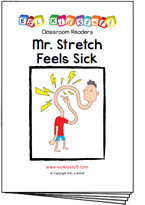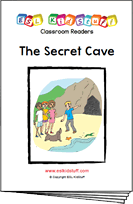Health & sickness lesson plan
Stand-alone lesson ESL kids lesson plan
Lesson plans for ESL kids teachers
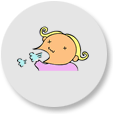
Health & sickness
In this lesson students practice talking and asking about health and sickness. Students play sickness vocabulary games, sing a song, read a funny story and perform doctor / patient role pays
Members get accompanying flashcards, worksheets, song and classroom reader.
Download materials:
Our lesson plans are FREE!
Sign up for accompanying:
✔ worksheets
✔ homework sheets
✔ craft sheets
✔ flashcards
✔ song downloads & videos
✔ classroom readers & videos
Click to see lesson details, materials and supplies
Time: 40 mins – 1 hour
Objectives: Talking and asking about health and sickness.
Structures: “What’s wrong?”, “What’s the matter with you?”, “[hide_on_uk]I have[/hide_on_uk][hide_on_us]I’ve got[/hide_on_us] a/an …”
Target vocabulary: a headache, a cough, a stomachache, a sore throat, a runny nose, an earache, a cold
Lesson materials
Flashcards:
- headache, cough, stomachache, sore throat, runny nose, earache, cold.
Printables:
- What’s wrong song 1 worksheet
- What’s wrong song 2 worksheet
- Reader worksheet
- What’s wrong? What’s the matter? song poster
Songs:
- What’s wrong? What’s the matter?
Readers:
- Mr. Stretch feels sick
Additional materials:
- xxx
Supplies:
- [hide_on_uk]colored[/hide_on_uk][hide_on_us]coloured[/hide_on_us] pencils
- Blu-Tack or something to stick flashcards onto the board
- doctor’s coat and a toy stethoscope for role-play (if you have them – don’t worry if you don’t!)
- board with marker / chalk
- device to play the song on
The lesson helps students to learn a lot of useful structures and vocabulary related to being ill and includes a nice, easy song to sing.
Lesson procedure:
Warm up and maintenance:
The beginning of your lesson is extremely important: this is where you set the tone of your lesson and get everyone in the right frame of mind for learning English. It is also an opportunity to check homework and review previous lessons.
Click for warm up suggestions for the start of your lessons
These activities can be done in the following order at the start of your lesson:

1. Greetings and name tags
Greet the students by name as they enter the classroom and gesture for them to sit down. Before class prepare some blank name tags (stickers or pin-on tags). Give these out and have everyone write their names and put their tags on. If you use pin-on tags, you can keep and give out every class.

2. Homework check
Check each student’s homework set in the last lesson. Ask each student some questions about their homework worksheet (e.g. “what [hide_on_uk]color[/hide_on_uk][hide_on_us]colour[/hide_on_us] is it?”), give lots of praise, and then put some kind of mark on the homework sheet (e.g. a sticker, a stamp or draw a smiley face). Finally, tell your students to put their homework back into their bags.
3. Review past lessons
Reviewing past lessons is very important – students need constant practice of new vocab, structures, songs, games and so on. Always review parts of your last lesson as well as some parts from other previous lessons. You can spend 5-10 minutes reviewing – it’s fine to recycle games and activities from your past lessons to review as kids enjoy playing familiar games (although be careful not to play a game to death!). See the section “Other ideas to include in your warm” below for ideas.
You can also include review activities in the main body of your lesson. Kids can have short attention spans so it’s good to be able to pull out lots of activities during different stages of the lesson.
Other ideas to include in your warm up:
Ball pass questions
This is good to review questions from previous lessons. Get everybody standing in a circle.
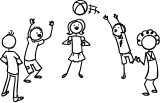
Round 1:
Take a ball and hold it and say, “My name is (you name)”. Then throw the ball to one student and say, “What’s your name?”. Students throw the ball around randomly, saying their names and asking for names.
Round 2:
This time ask a review question, e.g. “How many tables are there?”. Then throw the ball to a student who should answer, “There are (6) tables”. Help if necessary. Then that student throws the ball to another student and asks a “How many …?” question. Continue so everyone has a go. You can have multiple rounds with different topic questions.

Play “Spin the bottle”
Sit students in a circle with a bottle in the middle. Teacher spins the bottle. When it stops spinning the student it is pointing to has to answer a question. If the answer is correct then that student can spin the bottle. This is a good class warm up activity (e.g. How are you? What’s your [hide_on_uk]favorite[/hide_on_uk][hide_on_us]favourite[/hide_on_us] food? How’s the weather today?, etc.
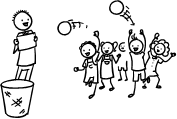
Play “Vocabulary basketball”
This is a fun game which reviews vocabulary from previous lessons. You will need a basket (a trash can) and 2 balls (or 2 pieces of A4 paper scrunched up into balls).
Form 2 teams and line them up so that two players from each team are facing the front with the basket in front of them. Let both players throw their ball – if they get their ball into the basket they can try and win a point by giving the correct answer to a question the teacher asks. This can be an actual question (e.g. What are you wearing?) or a flashcard (What’s this?). Then they go to the back of the line. At the end, the team with the most points is the winner!
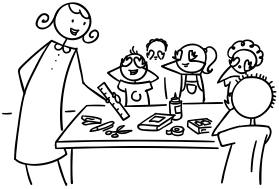
Play “What’s missing?”
This is a fun review memory game – students will have to try to remember review objects from previous lessons (e.g. classroom stationery). Lay the objects out on a table for all to see. Allow the students a minute to memorize the positions of the objects. Remove an object and hold it behind your back. Say, “Open your eyes!” – the first student who can shout out the missing object wins a point for his/her team. Play for all the objects.
Finally, calculate which team has won the most points and give them a round of applause.

Play “Quiz game show”
This is a fun quiz game, like a simple version of a TV game show. Draw some circles on the board and randomly write numbers 1, 2 or 3 in each circle. These will be points.
Put students into teams. Then ask the first team to choose a number – 1 is an easy question (e.g. “Do you like bananas?”) and 3 is a difficult question (e.g. point at a clock and ask, “What time is it?”). 2 will be in between in terms of difficulty. When the question has been answered correctly, erase that number circle. Play until all the number circles are gone – the team with the most points is the winner!
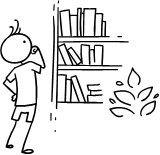
Read a classroom reader again
As you progress through the lessons you will start to build up a catalog of classroom readers (see our Readers download page at https://www.eslkidstuff.com). Kids love going back to old stories and reading through them again. Invite a student to pick a classroom reader and read through it as a class. Make the story as interactive as possible by asking questions (e.g. what [hide_on_uk]colors[/hide_on_uk][hide_on_us]colours[/hide_on_us] there are, the names of different objects, etc.) and getting students to speculate what is going to happen next in the story.

Talk about the weather (do after you have taught the weather lesson plan).
- Prepare a weather board. Before the first class prepare a piece of cardboard and cover it with felt – you are going to pin this to the wall. If you can, try and get blue felt (to represent the sky). Write at the top in large letters, “How’s the weather today?”. Below that write “Today it’s”. Cut out weather pictures (such as our weather flashcards) and stick some velcro on the back. Arrange the weather pictures around the edge of the board and then put the board on the wall of your classroom. You can now use this weather board at the beginning of every lesson.
- Ask about the weather. Ask, “How’s the weather today?” and have students put up their hands. Allow one weather condition per student (e.g. “It’s rainy”) and have each student come up and put a weather picture on the weather board.
- Introduce more weather vocabulary. Depending on weather conditions, you can introduce more weather words (with pictures … you can get students to draw them), such as:
- stormy
- misty
- showery
- freezing
- humid
- frosty
- icy
- drizzly
New learning and practice:
1. Play the “What gesture?” game
For this you can either give out a set of the health flashcards to each student (using the vocabulary from the song) or give out a copy of the “What’s wrong? What’s the matter?” song poster to each student and get them to cut out the images.
Start by standing in front of the class and doing the actions for one of the sickness words (e.g. hold your head and groan for “headache”). Students have to identify the picture you are acting out by holding up the flashcard or picture from their song poster. As you do each action say the vocabulary (e.g. “Oh no … [hide_on_uk]I have[/hide_on_uk][hide_on_us]I’ve got[/hide_on_us] a headache!”.
When you have finished put the students in pairs to act out and identify each vocabulary item. Don’t worry at this stage if they are not saying the words in English – this will come next.

2. Teach and practice the sickness vocabulary
Get everyone to put their pictures down and focus their attention towards the board. Prepare your sickness flashcards by putting some Blu-Tack, or something to make the card stick, on the top of each card on BOTH sides. Stick all the flashcards randomly (picture-side up) on the board and point to one (e.g. sore throat). Chorus the word 3 times. Then move on to the next card, chorusing 3 times. Go through all the cards.

Next, point to a card and elicit the vocabulary (Teacher: “What’s this?”; Students: “Sore throat”) and then turn the card over and stick it back on the board, blank side showing. Point to the card again and say, “What’s this?” and elicit the word for the hidden image (“Sore throat”). Now move onto the next card and do the same. Slowly you will turn all the cards over so you only have blank cards on the board.
Finally, do one more round, pointing at all of the blank cards and eliciting the vocabulary – you’ll be surprised how easily everyone will remember which each blank card is!
3. Teach the structures
Next you are going to teach “What’s wrong?”, “What’s the matter with you?” and “[hide_on_uk]I have[/hide_on_uk][hide_on_us]I’ve got[/hide_on_us] a/an …”.

Remove a card from the board and give it to a student. Say to that student, “What’s wrong?” or “What’s the matter (with you)?”. Help the student to reply, e.g. “[hide_on_uk]I have[/hide_on_uk][hide_on_us]I’ve got[/hide_on_us] an earache”.
Next, remove another card from the board and give it to a different student and ask the same question, eliciting the correct response. Do this for all of the cards.
Now, tell your class you are going to close your eyes for 5 seconds. In that time they will all swap cards amongst themselves. Close your eyes while everyone swaps cards. Open your eyes and say to one student, “What’s wrong?” and s/he should reply according to the card s/he has. Again, ask all the students with cards. You can do this swapping activity a few times if everyone enjoys it.
4. Pairs play “What’s wrong?” cards
Put everyone in pairs and get them to pile their cards or pictures, face down, on the table.
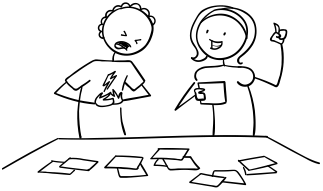
Student A picks up a card but doesn’t show Student B. Student B asks, “What’s wrong?” or “What’s the matter with you?” and Student A has to answer (e.g. “[hide_on_uk]I have[/hide_on_uk][hide_on_us]I’ve got[/hide_on_us] a stomachache”).
Then Student B has to do the gesture (e.g. for “stomachache”, rub their tummy). If Student B guesses the gesture s/he can keep the card for 1 point. The player with the most points is the winner.
5. Read classroom reader “Mr. Stretch feels sick”
Now we’ll reinforce the vocabulary with a fun story. Before class, download and print off the reader “Mr. Stretch feels sick”. As you go through each page, point to the pictures, elicit each key body part and sickness, and have your students copy the gesture that Mr. Stretch is doing, for example:
Teacher: (page 3) Oh dear, look at poor Mr. Stretch! What is he holding? (pointing at his head)
Students: His head!
Teacher: Yes, Look how big it is! What’s wrong with Mr. Stretch?
Students: [hide_on_uk]He has[/hide_on_uk][hide_on_us]He’s got[/hide_on_us] a headache!
Teacher: Yes, that’s right! (reading) “[hide_on_uk]I have[/hide_on_uk][hide_on_us]I’ve got[/hide_on_us] a headache”. Everyone copy Mr. Stretch!
(Student all hold their heads pretending to have a headache)
Teacher: (reading on page 4) “What else is wrong, Mr. Stretch?”. What is Mr. Stretch touching?
Students: His ear!
Teacher: Yes, Look how big it is! What’s the matter with Mr. Stretch?
Students: [hide_on_uk]He has[/hide_on_uk][hide_on_us]He’s got[/hide_on_us] an earache!
Teacher: Let’s see … (reading) “[hide_on_uk]I have[/hide_on_uk][hide_on_us]I’ve got[/hide_on_us] an earache”. Oh poor Mr. Stretch! [hide_on_uk]He has[/hide_on_uk][hide_on_us]He’s got[/hide_on_us] a headache and an earache! Everyone copy Mr. Stretch.
(Student all hold their ears pretending to have an earache)
etc.
Get the students really involved in the story by asking lots of questions and getting them to touch and say the parts of the body and sickness in the story.
After reading the story, give out a reader worksheet to each student and have everyone write the sickness vocabulary words under the pictures of Mr. Stretch. Then go through the answers as a class.
Alternatively, watch our video version of the reader (Internet connection required).
6. Sing the “What’s wrong? What’s the matter?” song
Now that all of the structures, vocabulary and gestures have been practiced it’s is time for the song. Get everyone to stand up and play the song through the first time, getting everyone to follow you as you sing and do the gestures (explained below). You can use the song poster to help (or put the flashcards on the board in the correct order of the song). Then play the song a couple more times until everyone has got the hang of it.
Lyrics for “What’s wrong? What’s the matter?”
Chorus:
Hello, hello,
What’s wrong? What’s wrong?
Hello, hello,
What’s the matter with you?
Verse 1:
I don’t feel well, I don’t feel well,
[hide_on_uk]I have[/hide_on_uk][hide_on_us]I’ve got[/hide_on_us] a headache, [hide_on_uk]I have[/hide_on_uk][hide_on_us]I’ve got[/hide_on_us] a headache.
I don’t feel well, I don’t feel well,
[hide_on_uk]I have[/hide_on_uk][hide_on_us]I’ve got[/hide_on_us] a cough, [hide_on_uk]I have[/hide_on_uk][hide_on_us]I’ve got[/hide_on_us] a cough.
I don’t feel well, I don’t feel well,
[hide_on_uk]I have[/hide_on_uk][hide_on_us]I’ve got[/hide_on_us] a stomachache, [hide_on_uk]I have[/hide_on_uk][hide_on_us]I’ve got[/hide_on_us] a stomachache.
I don’t feel well, I don’t feel well,
I don’t feel well today.
Chorus
Verse 2:
I don’t feel well, I don’t feel well,
[hide_on_uk]I have[/hide_on_uk][hide_on_us]I’ve got[/hide_on_us] a sore throat, [hide_on_uk]I have[/hide_on_uk][hide_on_us]I’ve got[/hide_on_us] a sore throat.
I don’t feel well, I don’t feel well,
[hide_on_uk]I have[/hide_on_uk][hide_on_us]I’ve got[/hide_on_us] a runny nose, [hide_on_uk]I have[/hide_on_uk][hide_on_us]I’ve got[/hide_on_us] a runny nose.
I don’t feel well, I don’t feel well,
[hide_on_uk]I have[/hide_on_uk][hide_on_us]I’ve got[/hide_on_us] an earache, [hide_on_uk]I have[/hide_on_uk][hide_on_us]I’ve got[/hide_on_us] an earache.
I don’t feel well, I don’t feel well,
I don’t feel well today.
Hmmm. It sounds like [hide_on_uk]you have[/hide_on_uk][hide_on_us]you’ve got[/hide_on_us] a cold!
Gestures for “What’s wrong? What’s the matter?”
The actions of the song really help to reinforce the vocabulary as your students will act out their illnesses as they sing.
- For the “Hello, Hello” part, wave as you sing.
- For the “What’s wrong?” and “What’s the matter with you?” parts put on a concerned expression and do the question gesture of palms facing up. Also, point forward on “you”.
- For the “I don’t feel well” parts, look really sad and clutch your head and stomach.
- For the sickness words act out the problem:
– headache: hold head in pain
– cough: hold hand over mouth and cough
– stomachache: rub stomach
– sore throat: hold throat and stick out tongue
– runny nose: wipe nose and sniff
– earache: hold ear in pain
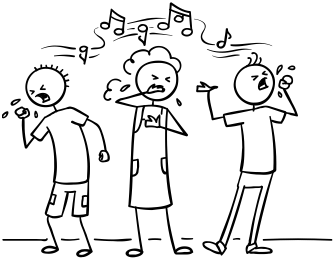
[hide_on_uk]Short sample (members get full-length song):
[/hide_on_uk]
[hide_on_us]Short sample (members get full-length song):
[/hide_on_us]

7. Do the “What’s wrong song 1” worksheet
Give out a worksheet to everyone and get them to fill in the answers. Walk around and ask questions as everyone is working.
8. Doctor / Patient role-plays
Now for a bit of fun. Ask for a volunteer student. Explain that you are the doctor and the student is the patient (who is very sick!). If you have a long, white coat and a toy stethoscope this will make the role-play even more realistic (and fun!).
First, create the scene – two chairs facing each other for the doctor’s office. Have the “patient” knock to enter the room and tell the patient to sit down. Ask, “What’s wrong?” and get the patient to say something (e.g. “[hide_on_uk]I have[/hide_on_uk][hide_on_us]I’ve got[/hide_on_us] a stomachache”. Then do an examination – e.g. take his pulse.
Then ask, “Ok, anything else?” and elicit another problem (e.g. “[hide_on_uk]I have[/hide_on_uk][hide_on_us]I’ve got[/hide_on_us] an earache”. Again do a medical examination – e.g. look down his throat.
Each time elicit more problems and do other examinations (e.g. listen to his back with the stethoscope, check knee reflexes, look in ears, etc.).
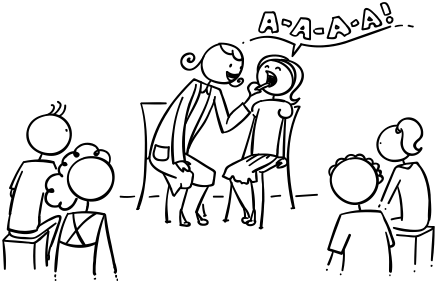
At the end say, “Hmmm. It sounds like [hide_on_uk]you have[/hide_on_uk][hide_on_us]you’ve got[/hide_on_us] a cold!”. Then prescribe something (e.g. “Go to bed and sleep all day”).
Now put the class into pairs and let them role-play. Let them have as much fun as they want, but keep circulating and helping with the target language. Finally, have the best pairs do their role-plays in front of the class.
Wrap up:
Assign homework: “What’s wrong song 2 worksheet” worksheet
Click for wrap up suggestions for the end of your lessons

1. Assign homework
Each week give out a homework worksheet for your students to take home. Hold up the homework worksheet and model how to do it. Give out the worksheets and say, “Put your homework in your bags”.

2. Do “Quick check”
Time to leave the class. Make sure everything is put away and the students have gathered their belongings. Have them line up at the door and place yourself between the door and the students. For each student check one new word or phrase, for example:
- hold up an object or flashcard (such as an item of clothing) and ask, “What’s this?”
- ask a question from the lesson (e.g. “Where do you live?”, “Do you like bananas?”, “Can you play chess?”, etc.)
When they give you the correct answer say goodbye and let them leave. If their answer is wrong, have them go back to the end of the line – they will have to try again once they reach the front!
Other lesson plans
Actions, verbs & tenses:
- Can – for ability
- Morning routines
- Daily routines & times of the day
- Actions – Present continuous
- Future plans using “going to”
- Past tense activities – Regular verbs
- Past tense activities – Irregular verbs: Part 1
- Past tense activities – Irregular verbs: Part 2
Adjectives:
- Describing people
- Describing things
- Comparing things (Comparative adjectives)
- Comparing things (Superlative adjectives)
Adverbs:
Alphabet:
Animals:
Body:
Classroom:
Clothes:
Colors:
Colours:
Directions:
Family:
Feelings & emotions:
Food:
Health & sickness:
Holidays & festivals:
Jobs:
Likes, dislikes & favorites:
Likes, dislikes & favourites:
- Likes & dislikes
- [hide_on_uk]Favorites[/hide_on_uk][hide_on_us]Favourites[/hide_on_us] and asking why
Nature & Our world:
Numbers:
Places & where we live:
Prepositions of location:
Pronouns:
Shapes:
Shopping:
Sports:
Time, days, months, seasons:
Toys:
Transport & travel:
Weather:


